Last Updated on January 18, 2024 by Greg Gillson
I’ve put this resource together for you to answer your question: What birds are in my backyard in West Virginia?
This article lists and discusses the identification of the most common birds in your backyard. The birds chosen in this article are compiled from actual data from the citizen science program eBird. Thus, it is more accurate than some other similar articles you may find on the web. I provide pictures of each bird species mentioned. I tell how to attract them to your backyard.
These are the most common backyard birds in West Virginia:
- Northern Cardinal
- American Crow
- Blue Jay
- American Robin
- Song Sparrow
- Tufted Titmouse
- Mourning Dove
- American Goldfinch
- Carolina Wren
- Downy Woodpecker
- Red-bellied Woodpecker
- European Starling
- White-breasted Nuthatch
- Carolina Chickadee
- Eastern Towhee
- Red-winged Blackbird
- Eastern Bluebird
- House Sparrow
- House Finch
- Pileated Woodpecker
- Northern Flicker
- Dark-eyed Junco
- White-throated Sparrow
- Red-eyed Vireo
- Indigo Bunting
- Gray Catbird
- Chipping Sparrow
- Cedar Waxwing
- Barn Swallow
- Wood Thrush
- Eastern Phoebe
- Common Grackle
- Scarlet Tanager
- Eastern Wood-Pewee
- Ruby-throated Hummingbird
- Chimney Swift
- Field Sparrow
West Virginia Birds and Birding in West Virginia State
eBird lists over 365 types of birds as occurring in the state of West Virginia.
The most common bird in West Virginia: the most frequently seen bird in the state is Northern Cardinal. It is reported on 52% of bird watching lists.
If you are serious about knowing the birds native to West Virginia, then check out eBird for West Virginia. It has recent sightings and photos, illustrated checklists with weekly abundance bar charts for state, counties, and individual hotspots of the best birding locations.
If you want to know about other people interested in birds in your area, join a local bird group. The American Birding Association maintains a list of bird watching clubs for each state.
West Virginia Bird Identification
This section is the species accounts. These are designed to help you to recognize birds you see in your backyard. I have used eBird to select the birds that are most common. “Common” means the birds seen most often throughout the year, not necessarily the most numerous.
Each species account starts with a photograph. In the identification section I am using size and shape and bill type before considering the color or patterns on the birds. I find these more reliable when trying to identify an unknown bird. Pay attention to body and tail shape and especially bill shape of birds you see, not just plumage color.
In the section on bird feeders and foods I tell how to attract each species. Not all types of backyard birds will come to feeders. But all backyard birds can be attracted with water. So don’t forget to add a birdbath to your bird feeding station.
Do you live in northern West Virginia? east West Virginia?
To appear in this article, most birds are widely distributed throughout the state and are often year-round residents. However, for those birds that are more localized in place or time, I list the general region and seasonality. Please see the section following these species accounts for the lists of common species by season.
Even if a species is found in a general area, they occur only in the habitat they prefer. So, the exact habitat of your neighborhood is important for the presence of absence of certain kinds of birds.
1. Northern Cardinal (Cardinalis cardinalis)
This is one of the most common and popular backyard birds in the eastern half of the United States.
 |
| Northern Cardinal. GeorgeB2 from Pixaby |
Range in West Virginia: Northern Cardinals are year-round residents throughout West Virginia.
Identification:
Size: Cardinals are a bit smaller than American Robins, about the same size as Red-winged Blackbirds.
Shape: Plump body with fairly long full tail. Wispy crest.
Bill: Short, heavy, conical, pink.
Color: That bright red color is matched by few other birds. Black face. The female is more gray, but with hints of red in wings and tail, and has a crest, too.
Habitat, range & behavior: Cardinals are year-round residents in shrubby woodland edges.
Found from the eastern United States to Texas and Arizona south into Mexico.
That large conical bill is made for chewing seeds. Watch them crack open sunflower seeds, spit out the hulls, and pluck the kernel with their tongues!
Food and feeder preference: Black oil sunflower seeds. Many types of seeds, berries, nuts in larger hopper or tray feeders.
You may like my in-depth article on attracting Northern Cardinals.
2. American Crow (Corvus brachyrhynchos)
This larger all-black bird is common in cities and country. Its cawing call is familiar to most people.
 |
| American Crow. Greg Gillson |
Range in West Virginia: American Crows are year-round residents throughout West Virginia.
Identification: This is a key species for comparing with an unknown bird.
Size: About 17-1/2 inches long from bill tip to tail tip, though there is much size variation throughout its range. Larger than blackbirds and grackles. Smaller than ravens.
Shape: Thick neck, large head, rather short square-ended tail. Longer legs. In flight has rounded wing tips with each primary feather separated from others forming “fingers.”
Bill: As long as head, thick, black.
Color: Glossy black throughout.
Habitat, range & behavior: They prefer open areas with trees, fields, farms, cities.
They are common across most of the United States lower-48, except in the desert southwest. They move into southern Canada in summer.
They gather in evening communal roosts in large flocks that may number into the thousands and then move out at dawn into the surrounding area.
Food and feeder preference: Omnivorous, they feed on large insects, grain, small mammals, carrion. You probably don’t want these large entirely-black birds in your backyard feeders. So don’t feed table scraps to birds.
3. Blue Jay (Cyanocitta cristata)
A common and well-known bird in the eastern half of the United States.
 |
| Blue Jay. skeeze from Pixabay |
Range in West Virginia: Blue Jays are year-round residents throughout West Virginia.
Identification:
Size: About that of American Robin.
Shape: Fluffy, large crested head, ample tail. Large strong legs.
Bill: Black, long and stout.
Color: Blue above, white below. Black neck collar. White patches in wing.
Habitat, range & behavior: Woodlands and towns.
Found in the eastern half of the United States. In summer into southern Canada.
Bold and brash. May bully smaller birds. Jays gulp lots of seeds or other food at once, storing it in their crop. Then they fly off and bury food items in a hidden cache.
Food and feeder preference: Omnivorous. They can quickly empty your feeder! Because they are also aggressive toward other feeder birds, some people put mesh cages around smaller bird feeders. Small birds can go through, squirrels and larger “pest” birds are prevented entry. Some people feed jays peanuts, perhaps away from the seed feeders.
4. American Robin (Turdus migratorius)
This familiar bird is a resident in the northern half of the United States and a winter visitor in the southern half.
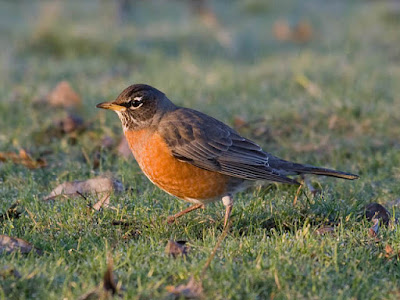 |
| American Robin. Greg Gillson |
Range in West Virginia: American Robins are year-round residents throughout West Virginia.
Identification: This is a key species for comparing with an unknown bird.
Size: 10 inches long from bill tip to tail tip. About the same size as a Blue Jay or one of the Scrub-Jays. Larger than Red-winged Blackbird. Smaller than a Mourning Dove.
Shape: Very plump with a fairly long tail.
Bill: Straight and fairly slender, curved at the tip.
Color: Gray-brown upperparts, rusty orange breast.
Habitat, range & behavior: Open woodlands, farmlands, urban parks and lawns.
Migratory, breeds north across Alaska and Canada. Resident in most of the United States (lower 48). Winters in the United States, Mexico, to central America.
Hops on your lawn turning head this way and that looking for food. Their caroling song is one of the early signs of spring in the north.
Food and feeder preference: Worms and other invertebrates in the lawn. May eat fruit from a tray feeder or the ground. Eat small berries from trees and bushes.
5. Song Sparrow (Melospiza melodia)
A common bird, but variable, and similar to many other streaked brown sparrows.
 |
| Song Sparrow. Greg Gillson |
Range in West Virginia: Song Sparrows are year-round residents throughout West Virginia.
Identification:
Size: A smaller bird, similar in size to House Finch and juncos. Larger than chickadees and goldfinches. Smaller than White-crowned Sparrows or Spotted/Eastern towhees.
Shape: Plump with round head, long rounded tail.
Bill: Short, conical.
Color: Highly variable in darkness and color saturation across its range (dark rusty to pale gray). Generally gray-brown above with dark brown streaking on back. Complicated head pattern. Streaking on sides and breast converge into dense central breast spot.
Habitat, range & behavior: Thickets, especially near water. Backyard shrubbery.
Resident in western United States, western Canada, coastal southern Alaska, northeastern US. In summer also moves into mid-Canada and northern half of US. In the winter found in most of the US lower-48. Also a population in central Mexico.
Forages on ground, never far from low cover to which they fly if startled.
Food and feeder preference: They feed on seeds and insects near the ground. Will visit hopper and tray feeders for mixed bird seed.
6. Tufted Titmouse (Baeolophus bicolor)
Related to chickadees, they lack the black bib, but have a crest instead.
 |
| Tufted Titmouse. anne773 from Pixabay |
Range in West Virginia: Tufted Titmice are year-round residents throughout West Virginia.
Identification:
Size: A small bird, but a large titmouse, this species is larger than chickadees, about the size of a junco or House Finch.
Shape: Rounded body, long full tail, big head, long legs.
Bill: Short and stout, compressed (taller than wide), black.
Color: Dark blue-gray above, pale below. Black feathers around eye accentuates its size.
Habitat, range & behavior: Lives in deciduous forests with heavy canopy, parks.
Found in eastern and southeastern United States is expanding its range north and west.
Backyard bird feeders might be helping this species expand its range northward.
Food and feeder preference: Insects and seeds. At your hopper or tray feeder they like black oil sunflower seeds and suet.
7. Mourning Dove (Zenaida macroura)
Mourning Doves are the most widespread and most frequent backyard bird in the Lower 48 states of the United States.
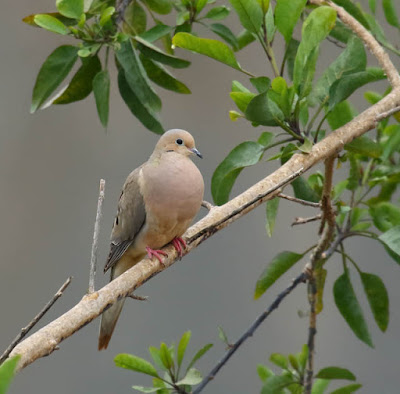 |
| Mourning Dove. Greg Gillson |
Range in West Virginia: Mourning Doves are year-round residents throughout West Virginia.
Identification: This is a key species for comparing with an unknown bird.
Size: About 12 inches long from bill tip to tail tip. About same size as Northern Flicker. Larger than American Robin. Slightly smaller than domestic city pigeon.
Shape: Very plump with a small round head. Tail is long and pointed. Legs are short.
Bill: Small and rather slender.
Color: Pale brown-pink body, darker wings and tail. White edges on side of tail.
Habitat, range & behavior: Semi-open areas such as urban areas, farmlands, woods. Often seen perched on wires, fences.
It is a resident across the lower-48 states and Mexico, with some movement out of northern areas in winter.
Their mournful cooing is a familiar spring birdsong.
Food and feeder preference: Mourning Doves eat seeds almost exclusively. Attract with black oil sunflower seeds on a large sturdy tray feeder or on the ground.
8. American Goldfinch (Spinus tristis)
A beautiful tiny finch familiar to many in its bright yellow summer plumage. Colloquially called a “wild canary.”
 |
| American Goldfinch. Greg Gillson |
Range in West Virginia: American Goldfinches are year-round residents throughout West Virginia.
Identification: This is a key species for comparing with an unknown bird.
Size: Very small at about 5 inches from bill tip to tail tip. Similar in size to a chickadee. Larger than hummingbirds. Smaller than juncos and House Finches.
Shape: Tiny, somewhat plump with larger head and short tail.
Bill: Short, conical, pink.
Color: Males in summer are bright lemon yellow with black forehead and black wings and tail with white bars. White under tail coverts. Females dull olive, wings and tail browner. Winter birds are pale grayish-yellow with tan and brown wings and tail.
Habitat, range & behavior: This species is found in weedy fields and similar clearings with thistles and similar plants.
It is found coast-to-coast throughout the year across most of the middle lower-48 states. In summer moves north to the Canada border. In the winter found south to the Mexico border.
The flight is highly undulating, rising and falling as they flap in short bursts. Besides a long, sweet lilting song, they call in flight a lilting 4-part: “potato chip!”
Food and feeder preference: Feeds on weed seeds, thistle seed. May eat black oil sunflower seeds from tube feeder. Love Nyjer seed in a feeder called a “thistle sock.”
You may like my article on attracting American Goldfinches.
9. Carolina Wren (Thryothorus ludovicianus)
This is a fairly common backyard bird in the much of the eastern United States.
 |
| Carolina Wren. theSOARnet from Pixabay |
Range in West Virginia: Carolina Wrens are year-round residents throughout West Virginia.
Identification:
Size: A smaller bird, between the size of American Goldfinch and House Finch.
Shape: Round body, short neck, flat head, long tail flipped about actively.
Bill: Fairly long, thin, pointed and slightly curved.
Color: Upper parts rusty brown with black bars on the wings and tail. A white eyebrow line and buff under parts.
Habitat, range & behavior: Shrubby thickets and brushy suburban yards.
It is found in the southeastern United States and Yucatan. Northern parts of range expand and contract depending upon harshness of winters.
Males sing throughout the year and are very loud for their size.
Food and feeder preference: Feed mostly on insects and spiders. They will feed on suet.
10. Downy Woodpecker (Dryobates pubescens)
This tiny woodpecker is found across the United States.
 |
| Downy Woodpecker. Greg Gillson |
Range in West Virginia: Downy Woodpeckers are year-round residents throughout West Virginia.
Identification:
Size: Bigger than a junco or House Finch. Smaller than a Red-winged Blackbird. About the same size as a White-crowned Sparrow, but with a much shorter tail.
Shape: Stocky with large head and short stiff tail.
Bill: Short, chisel-shaped.
Color: Black-and-white striped head. Black wings with white spots. Solid white back. White under parts. Black tail with white outer tail feathers with black bars or spots. Male with small red spot at back of head.
Habitat, range & behavior: Found in small deciduous trees, willows, and even weed stocks such as teasel, especially near water.
Ranges coast-to-coast across all but northernmost parts of Canada and Alaska south to the southern US. Absent in the desert southwest. Interestingly,
I learned today that the males may more often be found in smaller plants and twigs, while females are more likely on tree trunks.
Food and feeder preference: Insects, fruits, and seeds. Gleans arthropods from the bark of trees. Attract with suet feeder. Will also eat black oil sunflower seeds.
11. Red-bellied Woodpecker (Melanerpes carolinus)
This is one of the most common species in the eastern half of the United States.
 |
| Red-bellied Woodpecker. skeeze from Pixabay |
Range in West Virginia: Red-bellied Woodpeckers are year-round residents throughout West Virginia.
Identification:
Size: Fairly large for a backyard bird. Between a Starling and American Robin in size. Smaller than a Northern Flicker.
Shape: Stout with large head and short tail. Clings to tree trunk on strong short legs propped up with short stiff tail.
Bill: Long, chisel shaped.
Color: Pale gray body, many thin black-and-white bars across back and wings. Red nape, extending forward on crown on male.
Habitat, range & behavior: These birds are found in many woodland types, including oak, hickory and pine.
They are found from the eastern slope of the Rocky Mountains in the lower-48 states from Texas to extreme southern Canada, and eastward from Florida northward just to the southern edge of the New England states.
In typical woodpecker fashion, it hitches up the tree trunk and larger branches.
Food and feeder preference: This species eats insects and nuts. They may eat peanuts from a tray feeder and eat from a suet block.
12. European Starling (Sturnus vulgaris)
Introduced to North America in the late 1800’s, they crossed the continent, often to the detriment of native cavity-nesting birds. The prime example of an invasive species.
 |
| European Starling. Greg Gillson |
Range in West Virginia: European Starlings are year-round residents throughout West Virginia.
Identification: This is a key species for comparing with an unknown bird.
Size: 8-1/2 inches from bill tip to tail tip. About the size of a Red-winged Blackbird. Smaller than an American Robin. Larger than a White-crowned Sparrow or Spotted/Eastern towhee.
Shape: Stocky with large head, short square-ended tail. Longer legs.
Bill: As long as head. Sharp pointed. Yellow in spring, otherwise dark.
Color: They are grayish brown much of the year, with glossy iridescence and white spotting during the spring.
Habitat, range & behavior: Lowland birds that need trees large enough for nest cavities but plenty of open area for feeding. They are most abundant in urban and suburban areas where they find food and artificial nest cavities.
Resident from coast-to-coast from southern Canada to northern Mexico. In summer north across Canada and Alaska. Native range is Europe to Pakistan, north Africa.
Often viewed as a pest, starlings often bully other backyard birds, taking over bird feeders, and stealing nest cavities from smaller native birds. In winter they can form into flocks of tens of thousands.
Food and feeder preference: Primarily insects when available, often feeding on the ground. Discourage them from your backyard hopper and tray feeders by never feeding birds table scraps (including bread or meat). They have weak feet and do not perch well on tube feeders. A cage mesh around smaller hopper feeders may keep them out.
13. White-breasted Nuthatch (Sitta carolinensis)
A favorite feeder bird for many for its active antics and fearlessness. Though a small bird it is the largest nuthatch in North America.
 |
| White-breasted Nuthatch. Greg Gillson |
Range in West Virginia: White-breasted Nuthatches are year-round residents throughout West Virginia.
Identification:
Size: About chickadee-sized in length. Smaller than a junco or House Finch.
Shape: Appears large-headed, neckless, very short tailed. Short legs.
Bill: Nearly as long as head, straight, thin.
Color: Blue-gray above, white below. Black cap, wing tips, tail. Rusty feathers under tail.
Habitat, range & behavior: Common in oak and oak-pine woodlands, wooded towns.
Found across the United States, southern Canada, mountains of central Mexico. Absent from treeless grasslands, deserts in the west.
Crawls over tree branches and head-first down tree trunks searching for insects.
Food and feeder preference: Insects, seeds, acorns and other nuts. Love black oil sunflower seeds feeding on hopper and tray feeders. Suet blocks.
14. Carolina Chickadee (Poecile carolinensis)
Chickadees are common feeder birds throughout much of North America. This one is common in the southeastern United States.
 |
| Carolina Chickadee. GeorgeB2 from Pixabay |
Range in West Virginia: Carolina Chickadees are year-round residents throughout West Virginia.
Identification:
Size: This small bid is the size of an American Goldfinch.
Shape: Round body, round head, longer tail.
Bill: Short, straight, stout.
Color: Gray above. Paler below. Black cap, white face, black bib.
Habitat, range & behavior: Lower elevation deciduous forests, wooded residential areas.
This chickadee is a resident in the southeastern US.
Chickadees cannot chew as sparrows do, so they take one large sunflower seed at a time from your feeder and fly off to a branch to pound it open with their stout bills.
Food and feeder preference: Most of their diet is insects, also seeds. They will eat black oil sunflower seeds from hopper feeders.
15. Eastern Towhee (Pipilo erythrophthalmus)
This big ground-dwelling sparrow was recently split from Rufous-sided Towhee, creating the Eastern Towhee in the East and the Spotted Towhee in the West.
 |
| Eastern Towhee. skeeze from Pixabay |
Range in West Virginia: Eastern Towhees are summer residents throughout West Virginia, year-round residents in southern West Virginia.
Identification:
Size: About the length of a White-crowned Sparrow; larger than a House Finch, smaller than a Starling or Red-winged blackbird.
Shape: Rather bulky compared to other sparrows, large head, long rounded tail.
Bill: Short, conical.
Color: Blackish above, rusty sides, white belly. Females paler and browner. White tail corners. White wing patch.
Habitat, range & behavior: They live in brushy areas, hedges, woodland edges.
Found in the eastern United States. Resident in SE US, in summer the move north to the border with Canada.
They rummage around in leaf litter under thick bushes, kicking and scratching the ground with both feet at once.
Food and feeder preference: Eat mostly insects and invertebrates in summer, adding berries, fruits, and especially seeds in winter. At your feeder they will visit a hopper feeder, but may prefer a wide platform feeder. They may more often feed on the ground under the feeder.
16. Red-winged Blackbird (Agelaius phoeniceus)
These noisy flocking birds are most often found in marshes. But in winter they are found in backyards.
 |
| Male Red-winged Blackbird. Greg Gillson. |
 |
| Female Red-winged Blackbird. Greg Gillson. |
Range in West Virginia: Red-winged Blackbirds are year-round residents throughout West Virginia.
Identification: This is a key species for comparing with an unknown bird.
Size: About 8-3/4 inches long from bill tip to tail tip. About the size of a Northern Cardinal. Smaller than an American Robin.
Shape: Pot-bellied with a longer bill and flat forehead. Tail average.
Bill: Long and sharp pointed.
Color: Males are black with red and yellow shoulder patch. Females are streaked brown and rusty (sparrow-like but pointed bill and flat forehead).
Habitat, range, and behavior: Cattail marshes and wetlands are their summer habitat. In winter they feed in grain fields.
They breed across most of the North American continent. In winter they withdraw from most of Alaska and Canada.
They are found in colonies in summer and large flocks in winter.
Food and feeder preference: They eat insects in summer. In winter they eat grain and seeds. They visit feeders, more often in large winter flocks, and eat most seeds and suet.
17. Eastern Bluebird (Sialia sialis)
A beloved bird of open fields with trees and fence lines for perching.
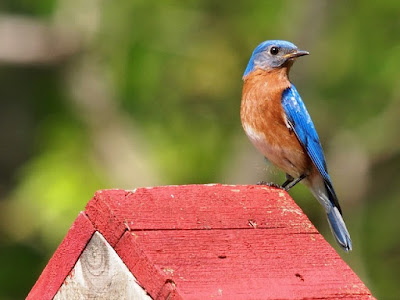 |
| Eastern Bluebird. skeeze from Pixabay |
Range in West Virginia: Eastern Bluebirds are year-round residents throughout most of West Virginia, but only summer residents in northern West Virginia.
Identification:
Size: Larger than House Finches. Much smaller than starlings. About length of White-crowned Sparrow but differently proportioned.
Shape: Chunky, large head, short tail.
Bill: Straight, fairly slender, curved at tip.
Color: Males are brilliant blue above (including wings and tail), rusty orange below with white belly and under tail. Females are often much paler, almost grayish.
Habitat, range & behavior: Found in pasture, fields, golf courses, open woodland edges.
They are resident in most of eastern US, highlands of Middle America. In summer reach northernmost eastern US and southernmost eastern Canada, withdrawing somewhat in winter.
They readily use nest boxes, but the entrance hole must be smaller than the head of a starling, and without a perch.
Food and feeder preference: They eat flying insects primarily, but also other invertebrates and berries. They will eat mealworms at your feeder and frequent birdbaths.
18. House Sparrow (Passer domesticus)
Like the starling, this is another bird introduced from Europe in the 1800’s. This sparrow is commonly found in cities and farmlands. It is considered a pest in most areas where it has been introduced.
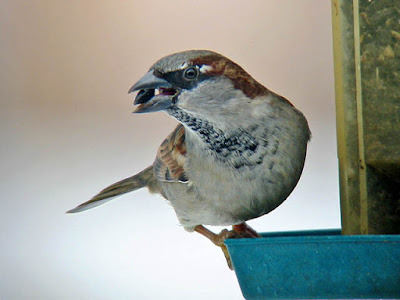 |
| House Sparrow. Greg Gillson |
Range in West Virginia: House Sparrows are year-round residents throughout West Virginia.
Identification:
Size: The size of a House Finch or Dark-eyed Junco.
Shape: Chunkier than native North American sparrows with large head, barrel chest, short neck, medium tail, short legs.
Bill: Short, conical.
Color: Males are brown and gray with a black mask. Females lack the black and are tan and brown with a pale line back from the eye.
Habitat, range & behavior: Cities and farms.
Range in North American from southern Canada through Central America. In summer northward through Canada to southern Alaska. Originated in Middle East and spread to most of Europe and Asia. Introduced in South America, Africa, Australia–nearly anywhere there are people and cities.
They tend to be messy… and have a good appetite and may occur in large noisy chirping flocks. They are aggressive toward other feeder birds.
Food and feeder preference: They eat grain, seed, and insects. To discourage them from your hopper and tray feeders do not feed birds human food scraps. They have a bit of difficulty eating from tube feeders.
19. House Finch (Haemorhous mexicanus)
These are one of the most common backyard birds in the United States. There are other red finches, but these are the ones most likely in residential areas.
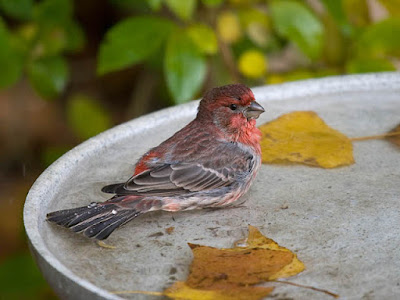 |
| House Finch. Greg Gillson. |
Range in West Virginia: House Finches are year-round residents throughout West Virginia.
Identification: This is a key species for comparing with an unknown bird.
Size: About 6 inches from bill tip to tail tip. Larger than goldfinches and chickadees. Smaller than a White-crowned Sparrows or Spotted/Eastern towhees.
Shape: Medium build with a medium-long notched tail. Round head.
Bill: Short, conical.
Color: Brown and gray above with streaks on the sides of the pale underparts. Males with red (sometimes orange or rarely yellow) crown, chest, rump.
Habitat, range & behavior: You’ll find small flocks on wires, in short tree tops and in bushes. Originally deserts and grasslands. Rural areas and towns are where they’re now most common.
Formerly found in the western United States and Mexico. Then introduced into the northeastern United States, but now found in nearly all of the lower-48 states and extreme southern Canada. Rare in plains states (Dakotas to Texas) and southern Florida.
House Finches are not territorial, but males sing throughout the year–a lively, wiry song ending in a couple of buzzy notes.
Food and feeder preference: House Finches love sunflower seeds and tube feeders. May eat from thistle socks.
You may like my in-depth article on attracting House Finches.
20. Pileated Woodpecker (Dryocopus pileatus)
This huge woodpecker is found in large timber.
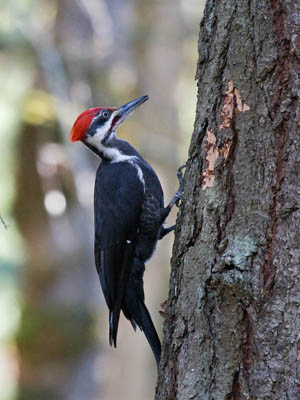 |
| Pileated Woodpecker. Greg Gillson. |
Range in West Virginia: Pileated Woodpeckers are year-round residents throughout West Virginia.
Identification:
Size: Large; the size of a crow. Bigger than a flicker.
Shape: Heavy body with a fairly long neck for a woodpecker. Big head, accentuated by large bill and flamboyant crest. Broad rounded wings. Short, wedge-shaped tail.
Bill: As long as head. Strong and chisel-shaped.
Color: Primarily black with white stripe on neck and face. Red crest. White underwing linings. White bases to the upper primaries.
Habitat, range & behavior: Found in dense mature forests with big trees.
They are found across Canada, conifer forests of the West Coast, and most of the East.
Drill with powerful strikes of their bill on trees live or dead. Look for their large rectangular holes in huge old stumps.
Food and feeder preference: Carpenter ants are their primary food. They will eat sunflowers and peanuts on platform feeders.
21. Northern Flicker (Colaptes auratus)
Of all the bird identification questions I get asked, this common larger backyard bird is the bird most people ask about. It doesn’t occur to those unfamiliar with it that this could be a woodpecker.
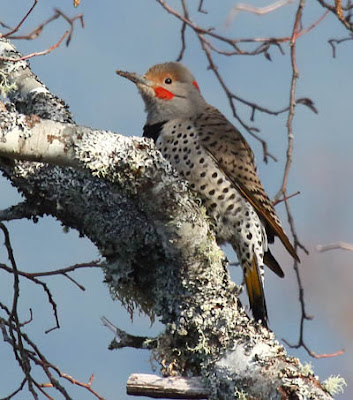 |
| Northern Flicker. Greg Gillson. |
Range in West Virginia: Northern Flickers are year-round residents throughout West Virginia.
Identification:
Size: About the size of a Mourning Dove. Larger than a robin.
Shape: Stocky with short legs, short tail, big head.
Bill: As long as head, thin, slightly curved.
Color: Back is brown with black bars. Under parts pinkish with black spots. Undersides of black wing and tail feathers are bright salmon red (West) or yellow (East). Head gray (West) or brown (East) and males with red (West) or black (East) whisker marks and nape marks (East). Black crescent across chest. White rump seen in flight.
Habitat, range & behavior: Found in woodland edges and forests.
Year-round resident from extreme southern Canada, across all of the lower-48 states and in the mountains of Mexico and Middle America. In summer breeds northward well into Canada and Alaska.
Frequently noted hopping on ground pecking in the ground for insects. In late spring, males proclaim their territory by rapid pounding on a hollow tree branch, though the ringing of metal downspouts at dawn is louder and carries much farther, to the exasperation of anyone trying to sleep inside!
Food and feeder preference: Ants and beetles are their primary foods. Will eat black oil sunflower seeds and are attracted to suet.
22. Dark-eyed Junco (Junco hyemalis)
Colloquially called “snow birds,” they often arrive in backyards in winter from nearby mountain forests or more northern climes.
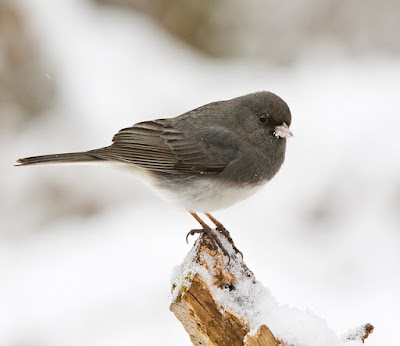 |
| Dark-eyed Junco. skeeze from Pixabay |
Range in West Virginia: Dark-eyed Juncos are winter visitors throughout West Virginia and year-round residents in the higher mountains of eastern West Virginia.
Identification:
Size: Small birds about the size of a House Finch.
Shape: Round body, short neck, round head, fairly long square-ended tail.
Bill: Short, pointed, conical, pink.
Color: Eastern birds are a darker all-gray with white belly. Western birds have jet black hood over head, brown back, and pink sides.
Habitat, range & behavior: Breed in coniferous forests. Winters widely. Avoids heavy brush, preferring widely spaced bushes.
Breeds across most of Canada, Alaska, and the western half of the United States. Winters from southern Canada and all of the lower 48-states to extreme northern Mexico.
Spend much of their time hopping and feeding on the ground.
Food and feeder preference: Eats mostly seeds, also insects in summer. Readily feed at backyard feeders on mixed seeds on hopper or tray feeders and ground.
You may like my in-depth article on attracting Dark-eyed Juncos.
23. White-throated Sparrow (Zonotrichia albicollis)
A fairly common bird of northern forests that visits backyards across much of the US.
 |
| White-throated Sparrow. Greg Gillson |
Range in West Virginia: White-throated Sparrows are winter visitors throughout West Virginia.
Identification:
Size: Similar in size to White-crowned Sparrow. Bigger than a House Finch; smaller than a starling.
Shape: Longer body. Round head on short neck. Long tail with notched tip.
Bill: Short. conical.
Color: Striped tan and brown above, pale gray below. White-striped form with black and white head stripes. Tan-striped form with tan and brown striped head. First year birds are similar to tan-stiped adults, but streakier overall. Yellow spot between eyebrow and bill. White throat strongly offset from gray breast and face.
Habitat, range & behavior: Found in forests, brush, and open woodland edges.
Breeds across Canada and northernmost Eastern United States. Winters in the eastern US, southern central US, and rare but regular along the West Coast.
Found in small flocks on ground near brush into which they can flee. Kick up leaves to search under for food.
Food and feeder preference: Eat seeds and berries in winter, more insects and fruit in summer. In your feeder will eat mixed seeds on a platform feeder and on the ground.
24. Red-eyed Vireo (Vireo olivaceus)
This is one of the most common songbirds in eastern woodlands.
 |
| Red-eyed Vireo. Greg Gillson. |
Range in West Virginia: Red-eyed Vireos are summer residents throughout West Virginia.
Size: Small, about the size of an American Goldfinch. Smaller than a House Finch.
Shape: Long and slim, but with rather short tail. Big-looking head.
Bill: Longer, stout. Pointed but small hook on end, as all vireos.
Color: They are olive-green above, white or with a hint of yellow below. Gray crown, bordered by black line, white eyebrow, and another thin black line through red eye.
Habitat, range & behavior: Tall deciduous trees, such as cottonwoods.
Breed across Canada, the Rocky Mountains and most of the East. Absent from much of the West and Southwest.
As with many vireos, they sing persistently through the summer and through the heat of the day, not just primarily during spring and at dawn as many other songbirds.
Food and feeder preference: They eat insects and will not come to feeders.
25. Indigo Bunting (Passerina cyanea)
Don’t mistake Indigo Buntings for the larger Blue Grosbeak. As the name suggests, the grosbeak has a much larger and thicker bill, along with rusty wing bars, lacking in Indigo Buntings.

Range in West Virginia: Indigo Buntings are summer residents throughout West Virginia.
Identification:
Size: These birds are a bit smaller than a House Sparrow.
Shape: Plump. Large round head. Medium short tail.
Bill: Large and conical.
Color: Males are deep blue. Females are pale gray-brown with diffuse streaks below.
Habitat, range & behavior: Open woodlands and clearings. Country farm roads.
They are found in the East and parts of the Southwest, north to southern Canada.
Sing from the tallest tip of tree or telephone lines, a cheerful paired bouncy song very similar to American Goldfinch. In fact, they are sometimes called “blue goldfinches” because of this!
Food and feeder preference: These birds will eat seeds from hopper feeders, perhaps more so in the late spring when they first arrive during migration.
26. Gray Catbird (Dumatella carolinensis)
This bird is rather common where it occurs, but a bit secretive.

Range in West Virginia: Gray Catbirds are summer residents throughout West Virginia.
Identification:
Size: About the length of a Red-winged Blackbird or Northern Cardinal.
Shape: Long tailed, round head.
Bill: Medium-length, pointed.
Color: Gray with a black tail and black cap. Rusty under tail coverts.
Habitat, range & behavior: Dense woodland edges, scrub, abandoned orchards.
Breeds in eastern and central US and adjoining southern Canada. Winters in extreme south US Gulf states, southward in eastern Mexico to Panama.
They spend much time hopping on the ground or in low bushes. They defend a winter territory, unlike most birds.
Food and feeder preference: Insects and berries. You may attract this species with jelly and fruit feeders, suet, and water.
27. Chipping Sparrow (Spizella passerina)
Chipping Sparrows are a widespread species adapted to human disturbance. They are rather tame. They are frequently found in cemeteries with large trees.
 |
| Chipping Sparrow. Greg Gillson. |
Range in West Virginia: Chipping Sparrows are summer residents throughout West Virginia.
Identification:
Size: These are small sparrows, bigger than goldfinches or chickadees, but smaller than House Finches or Song Sparrows.
Shape: Plump and fairly long-tailed.
Bill: Short and conical.
Color: Striped brown and dark brown above. Grayish under parts. Black line through eye. Crown streaked in winter but in summer becomes solid chestnut. Two white wing bars.
Habitat, range & behavior: Grassy open conifer woodlands with some shrubs, parks, orchards.
Breeds from Alaska, across Canada and south into highlands of Middle America. In winter retreats from northern areas to southern United States and northern Mexico.
In summer solitary or in pairs. In winter they forage in flocks of up to 50 birds.
Food and feeder preference: Weed seeds, supplemented with insects in summer. They may eat black oil sunflower seeds in your feeder, but more likely will feed on mixed seeds on the ground under the feeder.
28. Cedar Waxwing (Bombycilla cedrorum)
Waxy red tips to the wing feathers give these birds their unique name. Maybe it’s the fancy crest. Maybe it’s the bandit mask. Maybe it’s the yellow band at the tip of its tail. But these are one of my favorite birds.
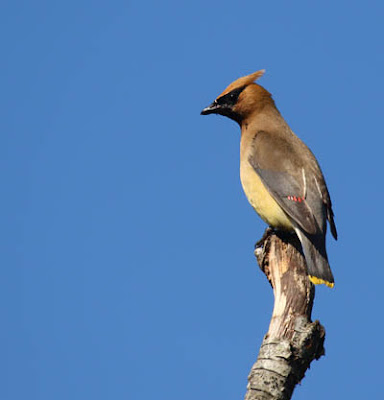 |
| Cedar Waxwing. Greg Gillson. |
Range in West Virginia: Cedar Waxwings are year-round residents throughout West Virginia.
Identification:
Size: Smaller than European Starling. Larger than House Sparrow.
Shape: Similar to European Starling. Rather stocky. Short squared tail, but long under tail coverts. Large head. Pointed wings. Wispy crest.
Bill: Rather short, small, wide.
Color: Warm brown above with wispy crest. Black mask. Yellowish belly. White under tail coverts. Gray wings. Gray tail with yellow tip.
Habitat, range, & behavior: Deciduous woods, wooded streams and lakeshores, residential shade trees, fruit orchards.
Resident across the northern US. Summer resident in Canada. Winter visitor throughout all of US and Mexico.
Keep in tight flocks. Feed in trees and large bushes for berries. Fly catch over ponds and streams.
Food and feeder preference: Berries and flying insects. Usually don’t come to feeders unless fruit like cherries offered, but will visit bird baths.
29. Barn Swallow (Hirundo rustica)
These swallows are widely distributed throughout the world, primarily breeding in the northern hemisphere, and wintering in the mid-latitudes and southern hemisphere.
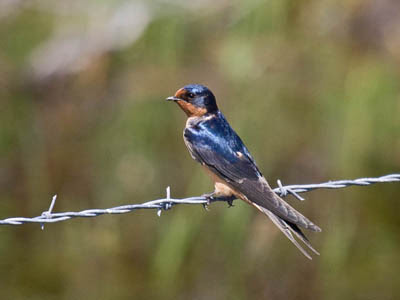 |
| Barn Swallow. Greg Gillson. |
Range in West Virginia: Barn Swallows are summer residents throughout West Virginia.
Identification:
Size: About the size of a House Finch but with a much longer tail.
Shape: Stocky, short necked but with long body and tail. Tail is forked, with very long outer tail feathers. Wings pointed.
Bill: Short, wide.
Color: Glossy dark purplish-blue above. Pinkish-orange below.
Habitat, range & behavior: Barn Swallows live in open country, frequently near humans. Farmlands. Nest in barns, under small bridges.
In North America breed from Mexico to northern Canada and Alaska, wintering from southern Mexico throughout most of South America.
Frequently seen swooping low over the ground hunting flying insects. Perch on wires, fences. Voice is twitters and chirps with grating sounds.
Food and feeder preference: Eat flying insects on the wing and are not attracted to backyard feeders.
30. Wood Thrush (Hylocichla mustelina)
A rusty forest bird of the eastern United States. A favorite songster.
 |
| Wood Thrush. Tony Castro. CC BY-SA 4.0 |
Range in West Virginia: Wood Thrushes are summer residents throughout West Virginia.
Identification:
Size: Just smaller than a Red-winged Blackbird. Between a sparrow and robin in size.
Shape: Plump with longer legs.
Bill: Pointed, but fairly thick.
Color: Rusty orange above. White eye ring. Black spots on white breast.
Habitat, range, and behavior: Found in deciduous and mixed woodlands.
Breeds in the eastern United States and adjacent southern Canada. Winters from southern Mexico to Panama.
The spend much of their time hopping on the ground, shuffling through the leaf litter.
Food and feeder preference: Don’t visit feeders.
31. Eastern Phoebe (Sayornis phoebe)
This plain bird is common in backyards in the East.

Range in West Virginia: Eastern Phoebes are summer residents throughout West Virginia, year-round residents in southern and southwestern West Virginia.
Identification:
Size: About the size of bluebirds. Larger than House Sparrows.
Shape: Rather stout, with long wings, medium-length tail. Pointed but flat bill. Upright posture.
Bill: Black, pointed, wide and flat.
Color: Brownish-gray above, slightly yellow-olive on sides. White under tail coverts. No eye ring or wing bars help distinguish them from some other flycatchers.
Habitat, range & behavior: Found in woodlands, suburbs, farms. Frequently nest in rafters, under eaves, porches.
They are summer residents east of the Rocky Mountains from Canada southward. Year-round residents through the interior of the Southeast, to Texas. Winter visitor to Gulf Coast and southern Atlantic.
Phoebes pump their tail down. They also frequently spread their tails.
Food and feeder preference: They eat flying insects that they catch on the wing. Not a feeder visitor.
32. Common Grackle (Quiscalus quiscula)
Sometimes considered a pest to crops, grackles are longer and lankier than very similar blackbirds.
 |
| Common Grackle. GeorgiaLens from Pixabay |
Range in West Virginia: Common Grackles are year-round residents throughout West Virginia.
Identification:
Size: Larger than Red-winged Blackbirds, they are near the length of Mourning Doves.
Shape: Long, with long full keel-shaped tail, long legs, flat crown.
Bill: Longer than head, pointed, but stouter than other blackbirds.
Color: Glossy black with hint of bronze or green on head (depending upon population). Yellow eye.
Habitat, range & behavior: They are found in agricultural areas, woodland edges, city parks and lawns.
Resident in the southeastern United States. In summer they migrate northward and west to the central United States and Canada.
They monopolize feeders and are bullies toward other birds.
Food and feeder preference: Grain, corn, acorns, small aquatic fish and amphibians. To discourage them, use tube feeders, rather than hopper or tray feeders. Don’t over-feed, keep spilled seed picked up.
33. Scarlet Tanager (Piranga olivacea)
These bright birds may be found high in your shade trees!
 |
| Scarlet Tanager. USFWS. Public domain. |
Range in West Virginia: Scarlet Tanagers are summer residents throughout West Virginia.
Identification:
Size: Larger than House Finch. Smaller than American Robin.
Shape: A well-proportioned bird, long body, large head, medium tail.
Bill: A bit shorter than the head, stout, curved on the upper ridge.
Color: Males are deep red with black wing and tail. Females are yellow-green with dark wing and tail.
Habitat, range, & behavior: They are found primarily in older deciduous and mixed woodlands.
They summer in the northern eastern United States. They winter in South America.
These birds tend to stick high in the treetops and can be hard to find when not singing.
Food and feeder preference: They eat insects and do not come to feeders. They do eat berries, though.
34. Eastern Wood-Pewee (Contopus virens)
Eastern Wood-Pewees and Western Wood-Pewees appear very similar. Their ranges nearly split the continent in half, east and west. Their song separates them; it is a clear whistled pee-a-wee in the Eastern Wood-Pewee, and a burry pee-yeear in the Western Wood-Pewee.
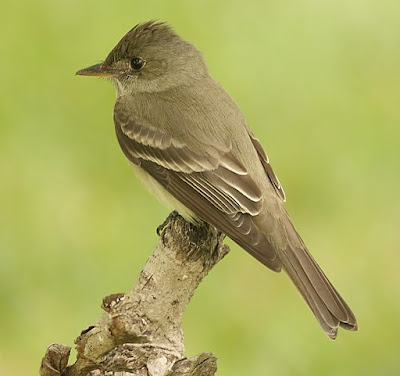 |
| Eastern Wood-Pewee. Tony Castro CC 4.0 |
Range in West Virginia: Eastern Wood-Pewees are summer residents throughout West Virginia.
Identification:
Size: Bigger than a House Finch; smaller than a bluebird.
Shape: Upright posture. Large head. Thick chest. Long tail. Long wings.
Bill: Medium length, wide at base. Black above; yellow-orange below.
Color: Grayish-olive above, slight yellow tinge below (looks white in strong light). Pale wing bars. No eye ring.
Habitat, range & behavior: Woodlands. Large shade trees in town.
Summer resident in the East, from southern Canada southward.
These flycatchers tend to perch on a dead twig high in the canopy. They sing throughout the day, attracting attention to this otherwise quite drab and nondescript bird.
Food and feeder preference: These birds feed on flying insects and do not come to feeders.
35. Ruby-throated Hummingbird (Archilochus colubris)
This is the only hummingbird that breeds in the eastern half of the United States and Canada.

Range in West Virginia: Ruby-throated Hummingbirds are summer residents throughout West Virginia.
Identification:
Size: A tiny bird, much smaller than any other in the eastern US, except perhaps some other rare hummingbird.
Shape: The small body is chunky, with a big head, and short tail.
Bill: Very long and tubular, slightly down curved.
Color: Metallic green above, white below with scattered green or gray feathers. Male with glimmering ruby red throat that is black unless it refracts sunlight at just the right angle.
Habitat, range & behavior: They find flowers at forest edges and flower gardens.
They summer in the eastern US and southern Canada, east of the Rocky Mountains. Some winter in from the coast of the Carolinas to Florida and along the Gulf Coast.
Darting flight on a blur of wings that buzz when they flap so fast! They feed by poking their long bill into flowers.
Food and feeder preference: They drink flower nectar from tubular flowers using their long brush-tipped tongue. They also feed on spiders and small flying insects. They are readily attracted to hummingbird feeders filled with sugar water.
36. Chimney Swift (Chaetura pelagica)
Swifts have such small weak feet that they cannot perch on wires or trees like swallows. Look for them high in the air chasing bugs with rapid wingbeats.
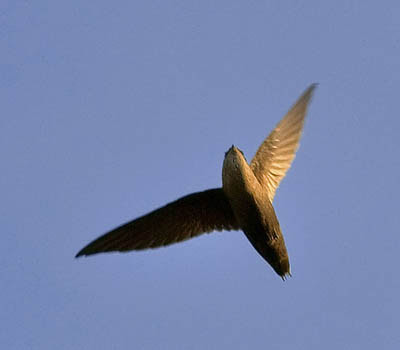 |
| Chimney Swift. Jim McCulloch CC 2.0 |
Range in West Virginia: Chimney Swifts are summer visitors throughout West Virginia.
Identification:
Size: Small bird. Smaller than House Finches or Cliff Swallows.
Shape: Small head on short neck, very short tail. Thin pointed wings with no apparent bend at the wrist as most other birds.
Bill: Very short, wide.
Color: Gray-brown throughout.
Habitat, range & behavior: Open sky, above forests or residential areas.
They are summer residents east of the Rockies from southern Canada southward. They do not winter in the United States.
In fall migration they form large flocks of hundreds or thousands and swirl into large chimneys at dusk. Because the upper arm is so short as to barely exist, the flight of swifts is described as rapid and twinkly, not smooth and graceful as swallows.
Food and feeder preference: Insects caught on the wing. Will not visit feeders.
37. Field Sparrow (Spizella pusilla)
These birds land on the top of ripe grasses and ride the grass down to the ground to hold the stem and feed on the seed head.
 |
|
Field Sparrow in Central Park. Rhododendrite. CC BY-SA 4.0 |
Range in West Virginia: Field Sparrows are year-round residents throughout West Virginia.
Identification:
Size: These are small sparrows, even smaller than Dark-eyed Juncos.
Shape: Slim. Long notched tail. Short bill.
Bill: Conical. Short. Pink.
Color: Gray face. Red lateral crown stripes. Striped back. White eye ring. Two white wing bars. Legs and bill pink.
Habitat, range & behavior: Found in overgrown field, woodland edges.
Year-round resident in the Southeast. Summers northward to eastern United States, barely southeastern Canada.
After breeding they form into flocks in weedy road edges and overgrown fields.
Food and feeder preference: Small grass seeds in winter. Insects in summer. At your feeder will eat the small seeds such as white proso millet from platform feeders or on the ground.
Common Birds in West Virginia
To determine how common each species is I used the data from actual bird sightings from the citizen science program eBird. Birds are listed by frequency. That is, how often the species is recorded on checklists submitted to eBird (a percentage).
When choosing the birds to include in this article I leaned strongly to birds that are present throughout the year in good numbers. Thus, many of the common birds are
year-round residents. This means that they live in the same location all year. They raise their young in your neighborhood. They don’t migrate. Or if the species does migrate, the ones living in your area don’t. If this is the case, some migrants may move into your area during certain times of year, adding to the same species that are in your yard full time.
Some migrant birds visit your yard during the “summer.” Often, they arrive in spring and remain until late fall. They nest and raise their young in your neighborhood. These are the summer residents.
Other migrant birds visit your backyard during the “winter.” Some of these winter visitors may arrive in July and remain into April. Others may only be found in the cold of December or January. They key here is that they nest and raise their young somewhere else. They only visit your yard in the non-breeding season.
Migration is an amazing spectacle. There will be birds that fly through your region in spring or fall (or both). They may visit your backyard only a few days or weeks a year. They aren’t regular enough, or stay long enough, to be included in this article. But the number of briefly visiting migrant birds could double the number of species presented here. You may see them over time. Consult checklists in eBird for your county to see what is possible.
I have generally excluded common waterfowl, birds of prey, shorebirds, seabirds, and others that aren’t usually found in residential areas. But they may certainly fly over or be seen regularly if your home is on a shoreline, for instance.
Most common backyard birds in West Virginia throughout the year
The following list is the backyard birds that are, on average, most common throughout the entire year. The list is ordered by most common based on the frequency of how often each species is recorded on checklists submitted to eBird.
- Northern Cardinal (50% frequency)
- American Crow (49%)
- Blue Jay (45%)
- American Robin (41%)
- Song Sparrow (41%)
- Tufted Titmouse (41%)
- Mourning Dove (37%)
- American Goldfinch (37%)
- Carolina Wren (34%)
- Downy Woodpecker (31%)
- Red-bellied Woodpecker (31%)
- European Starling (30%)
- White-breasted Nuthatch (30%)
- Carolina Chickadee (27%)
- Eastern Towhee (26%)
- Red-winged Blackbird (21%)
- Eastern Bluebird (20%)
- House Sparrow (20%)
- House Finch (20%)
- Pileated Woodpecker (19%)
- Northern Flicker (19%)
- Dark-eyed Junco (18%)
Most common backyard birds in West Virginia in winter
- Northern Cardinal (49% frequency)
- American Crow (47%)
- Tufted Titmouse (42%)
- Downy Woodpecker (38%)
- Blue Jay (38%)
- Song Sparrow (36%)
- White-breasted Nuthatch (36%)
- Dark-eyed Junco (34%)
- Carolina Wren (33%)
- Mourning Dove (32%)
- Red-bellied Woodpecker (32%)
- European Starling (30%)
- Carolina Chickadee (28%)
- American Goldfinch (28%)
- White-throated Sparrow (23%)
- House Sparrow (22%)
- House Finch (21%)
Most common backyard birds in West Virginia in summer
- American Robin (61% frequency)
- Northern Cardinal (47%)
- Song Sparrow (46%)
- American Crow (45%)
- American Goldfinch (44%)
- Eastern Towhee (43%)
- Mourning Dove (42%)
- Red-eyed Vireo (41%)
- Blue Jay (40%)
- Indigo Bunting (39%)
- Gray Catbird (35%)
- Chipping Sparrow (33%)
- Tufted Titmouse (31%)
- Carolina Wren (30%)
- European Starling (30%)
- Cedar Waxwing (29%)
- Barn Swallow (28%)
- Wood Thrush (25%)
- Eastern Phoebe (24%)
- Common Grackle (24%)
- Scarlet Tanager (24%)
- Red-bellied Woodpecker (23%)
- Eastern Bluebird (23%)
- White-breasted Nuthatch (22%)
- Eastern Wood-Pewee (22%)
- Downy Woodpecker (21%)
- Ruby-throated Hummingbird (21%)
- Chimney Swift (21%)
- Field Sparrow (20%)
- House Sparrow (20%)
How do birds differ between winter and summer?
Tufted Titmice, Downy Woodpeckers, White-breasted Nuthatches, Dark-eyed Juncos, White-throated Sparrows are more common in winter.
American Robins, Song Sparrows, American Goldfinches, Eastern Towhees, Mourning Doves, Red-eyed Vireos, Indigo Buntings, Gray Catbirds, Chipping Sparrows, Barn Swallows, Wood Thrushes, Eastern Phoebes, Scarlet Tanagers, Eastern Wood-Pewees, Ruby-throated Hummingbirds, Chimney Swifts are more common in summer.
Common Backyard Birds of Charleston, West Virginia
 |
| House Finch. Greg Gillson |
- Blue Jay (55% frequency)
- Northern Cardinal (51%)
- American Crow (43%)
- Song Sparrow (41%)
- Carolina Wren (41%)
- Mourning Dove (40%)
- Tufted Titmouse (39%)
- American Goldfinch (37%)
- Downy Woodpecker (36%)
- American Robin (35%)
- Carolina Chickadee (35%)
- House Finch (30%)
- White-breasted Nuthatch (26%)
- House Sparrow (23%)
- European Starling (22%)
- Red-bellied Woodpecker (22%)
Blue Jays and House Finches are more common in Charleston than in the rest of the state as a whole.
Red-bellied Woodpeckers are just a bit less common in Charleston, on average, than in the rest of the state as a whole.
Common Backyard Birds of Huntington, West Virginia
- Northern Cardinal (59% frequency)
- American Robin (54%)
- Song Sparrow (50%)
- Carolina Chickadee (38%)
- Mourning Dove (37%)
- Carolina Wren (37%)
- Blue Jay (37%)
- Eastern Towhee (36%)
- European Starling (36%)
- Downy Woodpecker (36%)
- American Crow (35%)
- Tufted Titmouse (34%)
- Red-bellied Woodpecker (29%)
- Red-winged Blackbird (29%)
- American Goldfinch (28%)
- Northern Mockingbird (25%) Learn about this species on eBird
- Common Grackle (24%)
- White-breasted Nuthatch (23%)
- White-throated Sparrow (20%)
Northern Cardinals, American Robins, Song Sparrows, Carolina Chickadees, Eastern Towhees, Red-winged Blackbirds are more common in Huntington than in the state of West Virginia as a whole.
American Crows, Blue Jays, American Goldfinches are less common in Huntington than in the state as a whole, on average.
Common Backyard Birds of Morgantown, West Virginia
- Northern Cardinal (53% frequency)
- American Crow (49%)
- Song Sparrow (48%)
- Blue Jay (45%)
- American Robin (43%)
- Tufted Titmouse (38%)
- Carolina Wren (38%)
- Carolina Chickadee (34%)
- Mourning Dove (31%)
- Red-bellied Woodpecker (31%)
- European Starling (30%)
- White-breasted Nuthatch (27%)
- Downy Woodpecker (27%)
- Eastern Towhee (26%)
- House Sparrow (25%)
- American Goldfinch (25%)
- House Finch (20%)
Song Sparrows are more common in Morgantown than in the rest of the state, on average.
American Goldfinches are less common in Morgantown than in the state of West Virginia as a whole.
Wrapping Up
West Virginia is known for its stunning landscapes and if you would like to explore outside your backyard, there are many more common birds to be found there. Here are some of my favorites:
Forests and Woodlands:
- Tufted Titmouse: Gray bird with a black cap and white wing patches, known for its clear “Peter, Peter, Peter” call and frequenting feeders.
- Carolina Chickadee: Small gray bird with a black bib and white wing bars, their “chick-a-dee” call is a familiar woodland sound.
- Carolina Wren: Small brown wren with a long tail and a loud, bubbling song, often found in undergrowth and brushy areas.
- Downy Woodpecker: Small black and white woodpecker with a white belly, their drumming sound echoes through the woods as they search for insects.
- Red-bellied Woodpecker: Larger woodpecker with a red head and belly, they have a loud drumming and a harsh “kuk” call.
- Gray Catbird: Gray bird with a black cap and long tail, known for mimicking other birds’ songs and foraging in dense foliage.
Waterways and Wetlands:
- Canada Goose: Large honking waterfowl, often seen in parks and ponds.
- Mallard: Green-headed duck with a white ring around neck, a common sight in ponds and lakes.
- Great Blue Heron: Tall wading bird with long legs and neck, often seen standing near water’s edge, patiently waiting for prey.
- Killdeer: Brown and white shorebird with long legs, their loud piercing “kill-deer” call is unmistakable, especially near wetlands.
Frequently Asked Questions
What is the state bird of West Virginia?
The Northern Cardinal is the proud state bird of West Virginia! These stunning birds, with their vibrant red plumage for males and subtle gray feathers for females, are a familiar sight across the state’s diverse landscapes. Their beautiful and complex whistling songs add to their charm, making them well-loved symbols of West Virginia’s natural beauty.
West Virginia residents proudly adopted the cardinal as their state bird in 1949, following a vote among public school students and civic organizations. Its connection to the state extends beyond its striking appearance, as its adaptability and resilience mirror the spirit of West Virginia and its people.
What kind of bird is black with a red head in West Virginia?
Several possibilities exist for a black bird with a red head in West Virginia, depending on specific details you may have:
Common possibilities:
Red-headed Woodpecker: This is the most likely candidate, a medium-sized woodpecker with a striking crimson head, black back and wings, and white underbelly. They drum on trees and love insects and fruits.
Brown Thrasher: These large brown thrushes have a red back and black head, but the red might appear darker depending on lighting. They have long curved bills and prefer dense thickets, singing loud, varied songs.
Less common possibilities:
House Finch: Although primarily brown, males have a vibrant red face and chest, which might appear black from a distance. They frequent feeders and have simple chirp songs.
Scarlet Tanager: These striking songbirds have bright red plumage overall with black wings and tail. They prefer dense forests and thickets, and males sing complex, musical songs.
Summer Tanager: Similar to the Scarlet Tanager, but males have a black mask around their red head. They also favor dense forests and woodlands.
What is a small black and white bird with a red neck?
The Rose-breasted Grosbeak is a beautiful songbird, but finding them in West Virginia requires some timing and knowledge of their preferred habitats:
Arrival: These birds migrate north to West Virginia in late April/early May and remain for breeding season until late July/early August. So, spotting them outside this timeframe is unlikely.
Habitat:
Look for Rose-breasted Grosbeaks in areas with mature deciduous forests and mixed woodlands, especially near edges and clearings.
They favor trees like oak, maple, beech, and hickory, where they find plenty of insects and fruit for food. Edges of fields and open areas bordering forests can also attract them, especially if they offer fruiting shrubs or trees.
Tips for finding Rose-breasted Grosbeaks:
Listen for their distinctive song: Males have a loud, clear, and complex song that includes whistles, buzzes, and imitations of other birds.
Observe feeding behavior: They forage mostly in trees and shrubs, searching for insects, caterpillars, berries, and seeds.
Check bird feeders: Sometimes, they visit feeders stocked with sunflower seeds, millet, or safflower seeds.
Visit known hotspots: Some parks and nature reserves in West Virginia are known for attracting Rose-breasted Grosbeaks, like:
-
- Blackwater Falls State Park: Tucker County
- Canaan Valley Resort State Park: Tucker County
- Seneca State Park: Pendleton County
- Dolly Sods Wilderness: Tucker County
Related Articles:
34 of the most common birds in the United States (with photos)











my cam in Wetzel, WV got a pic of unusual bird. it's in flight and it's tail feathers are spread apart as you would spread your fingers. from bottom the body is grayish with dark lines and feathers are orangish. id? I could send pic
I don't have a place for you to send photos. However, I have a couple of ideas.
The under tail coverts of the Gray Catbird are rusty orange.
The base of the tail of American Redstart is reddish-orange.